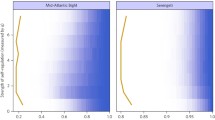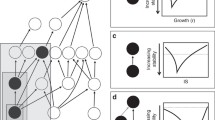Abstract
Large, complex networks of ecological interactions with random structure tend invariably to instability. This mathematical relationship between complexity and local stability ignited a debate that has populated ecological literature for more than three decades. Here we show that, when species interact as predators and prey, systems as complex as the ones observed in nature can still be stable. Moreover, stability is highly robust to perturbations of interaction strength, and is largely a property of structure driven by predator–prey loops with the stability of these small modules cascading into that of the whole network. These results apply to empirical food webs and models that mimic the structure of natural systems as well. These findings are also robust to the inclusion of other types of ecological links, such as mutualism and interference competition, as long as consumer–resource interactions predominate. These considerations underscore the influence of food web structure on ecological dynamics and challenge the current view of interaction strength and long cycles as main drivers of stability in natural communities.





Similar content being viewed by others
References
Arim M, Marquet PA (2004) Intraguild predation: a widespread interaction related to species biology. Ecol Lett 7:557–564
Bascompte J, Melian CJ (2005) Simple trophic modules for complex food webs. Ecology 86:2868–2873
Bascompte J, Melian CJ, Sala E (2005) Interaction strength combinations and the overfishing of a marine food web. Proc Natl Acad Sci USA 102(15):5443–5447
Berlow EL, Neutel AM, Cohen JE, de Ruiter PC, Ebenman B, Emmerson M, Fox JW, Jansen VAA, Jones JI, Kokkoris GD, Logofet DO, McKane AJ, Montoya JM, Petchey O (2004) Interaction strengths in food webs: issues and opportunities. J Anim Ecol 73(3):585–598
Bodini A (2000) Reconstructing trophic interactions as a tool for understanding and managing ecosystems: application to a shallow eutrophic lake. Can J Fish Aquat Sci 57:1999–2009
Brose U, Williams R, Martinez N (2006) Allometric scaling enhances stability in complex food webs. Ecol Lett 9: 1228–1236
Cohen J, Briand F, Newman C (1990) Community food webs: data and theory. Springer, Berlin, Germany
Dambacher JM, Li HW, Rossignol PA (2002) Relevance of community structure in assessing indeterminacy of ecological predictions. Ecology 83(5):1372–1385
Dambacher JM, Luh HK, Li HW, Rossignol PA (2003) Qualitative stability and ambiguity in model ecosystems. Am Nat 161(6):876–888
Daniels J, MacKay AL (1974) Stability of connected linear-systems. Nature 251(5470):49–50
Deangelis DL (1975) Stability and connectance in food web models. Ecology 56(1):238–243
Dunne J (2006) Ecological networks: linking structure to dynamics in food webs. Oxford Univ. Press, Chap The network structure of food webs, pp 27–86
Emmerson M, Raffaelli D (2004) Predator prey body size, interaction strength and the stability of a real food web. J Anim Ecol 73:399–409
Fussmann G, Heber G (2002) Food web complexity and chaotic population dynamics. Ecol Lett 5:394–401
Haydon D (1994) Pivotal assumptions determining the relationship between stability and complexity: an analytical synthesis of the stability-complexity debate. Am Nat 144(1):14–29
Hutchinson GE (1959) Homage to Santa Rosalia or why are there so many kinds of animals. Am Nat 93:145–159
Ives A (1995) Measuring resilience in stochastic systems. Ecol Monogr 65:217–233
Jansen VAA, Kokkoris GD (2003) Complexity and stability revisited. Ecol Lett 6(6):498–502
Jeffries C (1974) Qualitative stability and digraphs in model ecosystems. Ecology 55(6):1415–1419
Lafferty K, Dobson A, Kuris A (2006) Parasite dominates food web links. Proc Natl Acad Sci U S A 103:11, 211–11, 216
Lawlor LR (1978) Comment on randomly constructed model ecosystems. Am Nat 112(984):445–447
Levins R (1975) Ecology and evolution of communities, Harvard Univ. Press, Cambridge, Chap Evolution in communities near equilibrium, pp 16–50
Logofet DO, Ulianov NB (1982) Sign stability in model-ecosystems – a complete class of sign-stable patterns. Ecol Model 16(2-4):173–189
Martinez N, Williams R, Dunne J (2006) Ecological networks. Linking structure to dynamics in food webs. Oxford Univ. Press, Chap Diversity, complexity, and persistence in large model ecosystems, pp 163–186
May RM (1972) Will a large complex system be stable? Nature 238(5364):413–414
May RM (1973) Qualitative stability in model ecosystems. Ecology 54(3):638–641
May R (1974) Stability and complexity in model ecosystems. Princeton Univ. Press
May R (2006) Network structure and the biology of populations. Trends Ecol Evol 21:394–399
McCann K, Hastings A, Huxel GR (1998) Weak trophic interactions and the balance of nature. Nature 395(6704):794–798
McCann KS (2000) The diversity–stability debate. Nature 405(6783):228–233
Milo R, Shen-Orr S, Itzkovitz S, Kashtan N, Chklovskii D, Alon U (2002) Network motifs: simple building blocks of complex networks. Science 298(5594):824–827
Montoya J, Pimm S, Sole R (2006) Ecological networks and their fragility. Nature 442(7100):259–264
Neutel AM, Heesterbeek JAP, de Ruiter PC (2002) Stability in real food webs: weak links in long loops. Science 296(5570):1120–1123
Pascual M, Dunne J (eds) (2006) Ecological networks. Linking structure to dynamics in food webs. Oxford Univ. Press
Pimm S (1982) Food webs. Chapman & Hall, New York
Prill RJ, Iglesias PA, Levchenko A (2005) Dynamic properties of network motifs contribute to biological network organization. PLoS Biol 3(11):1881–1892
Puccia C, Levins R (1985) Qualitative modeling of complex systems: an introduction to loop analysis and time averaging. Harvard Univ. Press, Cambridge
Rooney N, McCann K, Gellner G, Moore J (2006) Structural asymmetry and the stability of diverse food webs. Nature 442:265–269
Sole R, Alonso D, McKane A (2002) Self-organized instability in complex ecosystems. Phil Trans Roy Soc Lond B 357: 667–681
Tilman D (1999) The ecological consequences of changes in biodiversity: a search for general principles. Ecology 80:231–251
Williams RJ, Martinez ND (2000) Simple rules yield complex food webs. Nature 404:180–183
Willmer C, Sinha S, Brede M (2002) Examining the effects of species richness on community stability: an assembly model approach. Oikos 99:363–367
Yodzis P (1981) The stability of real ecosystems. Nature 289(5799):674–676
Acknowledgements
We thank D. Alonso, A. Bodini, J.M. Dambacher and A. P. Dobson for stimulating discussions. This work was supported by a Centennial Fellowship by the J. S. McDonnell Foundation to M.P.
Author information
Authors and Affiliations
Corresponding author
Electronic Supplementary Material
Below is the link to the electronic supplementary material
Supplementary Fig. 1
Number of right-signed terms in the characteristic polynomial of the system represented in Figure 3. (a) percentage of terms with the right sign for each coefficient of the characteristic polynomial. (b) Sign difference: number of terms with the right sign - number of terms with the wrong sign (EPS 5.85 kb)
Supplementary Fig. 2a
Percentage of food webs, built with the “cascade model” (left) and the “niche” model (right), that are stable given C and S (EPS 29.6 kb)
Supplementary Fig. 2b
(EPS 26.2 kb)
Supplementary Fig. 3
Comparison between random matrices (left) and random predator-prey matrices (right) when interaction strengths are drawn from a lognormal (μ = 0, σ = 1) distribution. (a-b) Percentage of stable systems for each pair (C, S). (c-d) Average percentage of eigenvalues with negative real part. (e-f) Percentage of stable matrices produced by randomizing 100 times the coefficients of each stable matrix in (a-b). The number of matrices concurring to form this average is not fixed, as in the previous graphs, depending on the number of stable matrices (a-b). The dots represent the values of 10 empirical food webs (EPS 111 kb)
Supplementary Fig. 4
Comparison between random matrices (left) and random predator-prey matrices (right) when interaction strengths are drawn from an uniform (U[0,1]) distribution. (a-b) Percentage of stable systems for each pair (C, S). (c-d) Average percentage of eigenvalues with negative real part. (e-f) Percentage of stable matrices produced by randomizing 100 times the coefficients of each stable matrix in (a-b). The number of matrices concurring to form this average is not fixed, as in the previous graphs, depending on the number of stable matrices (a-b). The dots represent the values of 10 empirical food webs (EPS 117 kb)
Supplementary Fig. 5
Percentage of stable systems when 10% of the connectance is represented by double (mutualism or interference) connections (top). In the bottom graph we see the effects on stability of increasing the percentage of double interactions. The solid line represents the effects on predator-prey systems and the dashed line the effects on random networks (EPS 38.4 kb)
Supplementary Fig. 6
Effects on stability of increasing the percentage of null (left) or positive (right) coefficients on the diagonal. The solid line represents the effects on predator-prey systems and the dashed line the effects on random networks. In the right part of the graph, red dashed and solid lines represent the fraction of systems with negative trace (EPS 6.76 kb)
Supplementary Fig. 7
Comparison between random matrices (left) and random predator-prey matrices (right) when diagonal elements are positive with 5% probability and null with 5% probability. The other diagonal coefficients are negative. (a-b) Percentage of stable systems for each pair (C, S). (c-d) Average percentage of eigenvalues with negative real part. (e-f) Percentage of stable matrices produced by randomizing 100 times the coefficients of each stable matrix in (a-b). The number of matrices concurring to form this average is not fixed, as in the previous graphs, depending on the number of stable matrices (a-b). The dots represent the values of 10 empirical food webs (EPS 110 kb)
Supplementary Fig. 8
Effects of the distribution range on the probability of stability illustrating that the fraction of weak interactions has no effect on the probability of stability. We built 500 networks of the random (red) and predator-prey (blue) type. Each network contains 25 species and has connectance 0.1. The coefficient strengths are taken from a χ 2 distribution with k degrees of freedom. The coefficient signs are chosen as in the main text. Changing the degree of freedom reduces the fraction of weak interactions and moves the mean of the distribution toward higher values (EPS 8.71 kb)
Supplementary Table 1
Transformation of food webs into community matrices (PDF 39.5 kb)
Supplementary Table 2
Numerical computation of the number of terms with the right sign in a predator-prey matrix that is completely connected (PDF 33.6 kb)
12080_2007_7_MOESM11_ESM.pdf
Network structure, predator-prey modules, and stability in large food webs: Electronic Supplementary Material (ESM) (PDF 116 kb)
Rights and permissions
About this article
Cite this article
Allesina, S., Pascual, M. Network structure, predator–prey modules, and stability in large food webs. Theor Ecol 1, 55–64 (2008). https://doi.org/10.1007/s12080-007-0007-8
Received:
Accepted:
Published:
Issue Date:
DOI: https://doi.org/10.1007/s12080-007-0007-8




